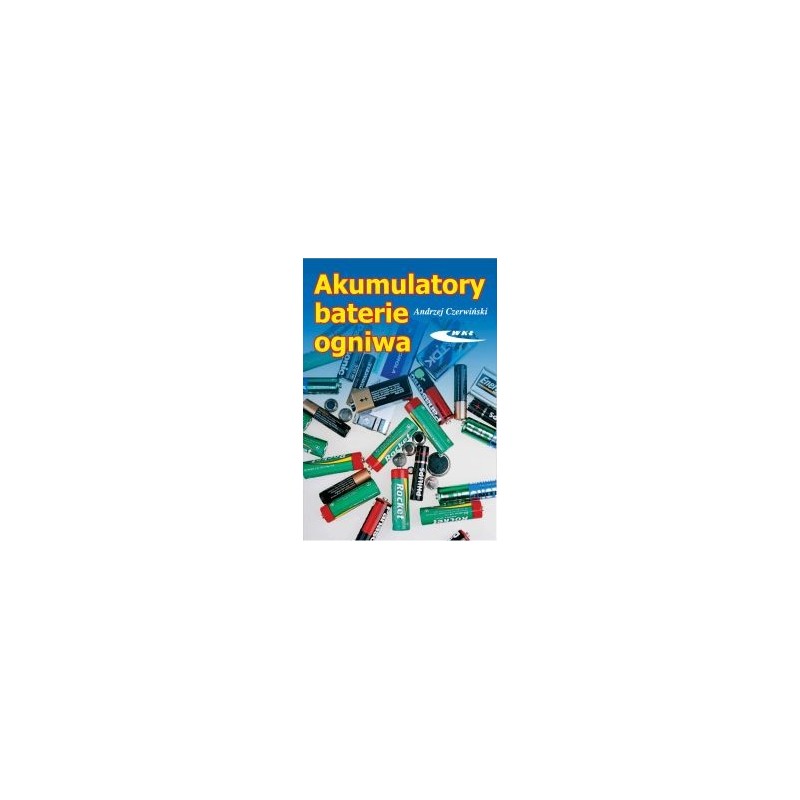- Out-of-Stock



Andrzej Czerwiński
A well-written book that promotes the construction of modern chemical energy sources and their applications in technology and everyday life. It contains a description of primary cells (zinc-manganese, zinc-mercury oxide, zinc-silver oxide, metal-air, reserve and lithium), reversible cells (lead-acid batteries, cadmium-nickel and iron-nickel batteries, hydride cells, zinc-reversible manganese and lithium, zinc-nickel, reversible with silver oxide as cathode, high temperature, solid, REDOX, type "Supercapacitors", hybrid rechargeable) and fuel cells (alkaline, with polymeric electrolyte, acidic, with molten coals, with solid oxides, methanol) and others) along with their application. Batteries used in electric vehicles with particular emphasis on fuel cells were discussed.
Professor dr hab. Jan M. Skowroński from the Institute of Chemistry and Technical Electrochemistry of the Poznan University of Technology writes, among others about the book "In my opinion, the author has managed a difficult thing, namely reconciling the features of the source of scientific and technical knowledge with a clear promotional character. power sources. " Review in the journal ELEKTRONIK No. 11/2005
Andrzej Czerwiński in his publication in a very accessible way communicates broad knowledge about the construction of modern chemical energy sources and their applications in technology and everyday life. The book contains a description of primary and reversible cells and fuel cells together with their use. Batteries used in electric vehicles with particular emphasis on fuel cells are discussed. The reader can learn how links were made and how the progress in their use and modernization progressed. The author also addresses the very important issues of contemporary legal regulations in Poland and the European Union regarding the production, recovery and disposal of waste batteries and accumulators. Noteworthy is the form of transfer of scientific knowledge to the subject of the reader's chemical energy sources that is very accessible to everyone interested. (KW)
Table of Contents:
Introduction 8
1. A little bit of theory and history 11
1.1. History of galvanic cells 11
1.1.1. It all began in ancient times 11
1.1.2. Alexander Volta - father of modern batteries 13
1.1.3. Most of the currently popular links were created
already in the 19th century 16
2. Are all batteries the same? Some information
general for users 22
2.1. Divisions of galvanic cells 22
2.2. What interferes with the work of the cell? 26
2.3. How do we calculate the energy stored in the cell? 28
2.4. How to connect cells to get new batteries? 31
2.5. Principles of exploitation of galvanic cells 32
3. Primary cells 34
3.1. Zinc-manganese cells 35
3.1.1. Leclanché cells are often called links
zinc-carbon 35
3.1.2. The work of the cell depends on the quality of the materials used
electrodes 36
3.1.3. "Parasitic" reactions occurring not only during
work of the cell 40
3.2. What has been done to improve the work of the cell? 44
3.2.1. Zinc-carbon chloride cells, another modification
links of Leclanché 46
3.2.2. Alkaline zinc-manganese batteries 46
3.2.3. What should the battery user remember about? 50
3.3. Further modifications of the Leclanché cell 51
3.3.1. Zinc-mercury oxide cells (mercury cells) 51
3.3.2. Zinc-silver oxide battery (I) 54
3.3.3. Metal-air cells 56
3.4. Can only zinc in the batteries be an anode? Or
on other types of primary batteries 62
3.5. Lithium cells - a revolution in the field of batteries 63
3.5.1. Lithium cells with insoluble cathodes 70
3.5.2. Lithium cells with soluble cathodes 78
3.5.3. Lithium cells with liquid cathodes 82
3.6. Summary 85
4. II type cells (reversible) 86
4.1. Automotive industry - demand for cells 89
4.2. Lead-acid batteries (lead-acid) 96
4.3. Nickel-cadmium batteries 114
4.3.1. Summary - what we should remember
about nickel-cadmium batteries 124
4.4. Batteries with iron anode 125
4.4.1. Iron-cadmium batteries 125
4.4.2. Silver and iron cells 127
4.5. Hydride cells (Ni-MH) 127
4.6. Lithium batteries of the second type 133
4.6.1. Cells with solid lithium anode, constant cathode
and liquid electrolyte 134
4.6.2. Cells with intercalated lithium and its ions
in fixed electrodes 137
4.6.3. Cells with solid polymer electrolyte 141
4.6.4. Cells with a polymer positive electrode (cathode) 142
4.6.5. Summary of lithium cells 142
4.7. High temperature cells 143
4.7.1. Cells with solid electrolyte 144
4.7.2. Summary 147
4.8. Summary of the chapter about batteries 148
5. Fuel cells 152
5.1. Introduction 152
5.2. Fuel cells with polymer electrolyte (PEMFC) 156
5.3. High temperature fuel cells 159
5.4. Alkali fuel cells 160
5.5. How to store fuel? 162
5.6. Fuel cells (DAFC) 165
5.6.1. Methanol fuel cells (DMFC) 165
5.7. Summary 168
6. Hybrid cells - something intermediate between
batteries and fuel cells 170
6.1. Reversible zinc-air cells 170
6.2. Iron and air batteries 172
7. Are there other links? 174
8. Supercapacitors - how you can
store the electric charge 175
9. EU and RP law on batteries and batteries 177
10. Supplement 181
10.1. How do links work? 181
10.2. What is electromotive force? 184
Bibliography 186
No product available!
No product available!
Permanent cylindrical neodymium magnet with a diameter of 3 mm and a height of 1,5 mm.
No product available!
ESD-13 tweezers 120mm straight. Antistatic, antimagnetic, acid resistant with hardness HRC40. Coated gripping part. Ideal for work in SMD electronics.
No product available!
Development kit with Xilinx Spartan 3A FPGA. Equipped with a display, buttons, audio and video output and a microSD slot. Numato Lab FPGAX0006
No product available!
No product available!
No product available!
No product available!
No product available!
No product available!
Male terminal block, angled, 4-pin. Pitch 3.81mm. Height 7mm. 15EDGRC
No product available!
No product available!
Printed circuit board and programmed circuit for universal timer 0 to 99min. AVT3200 A +
No product available!
No product available!
No product available!
No product available!

Andrzej Czerwiński
